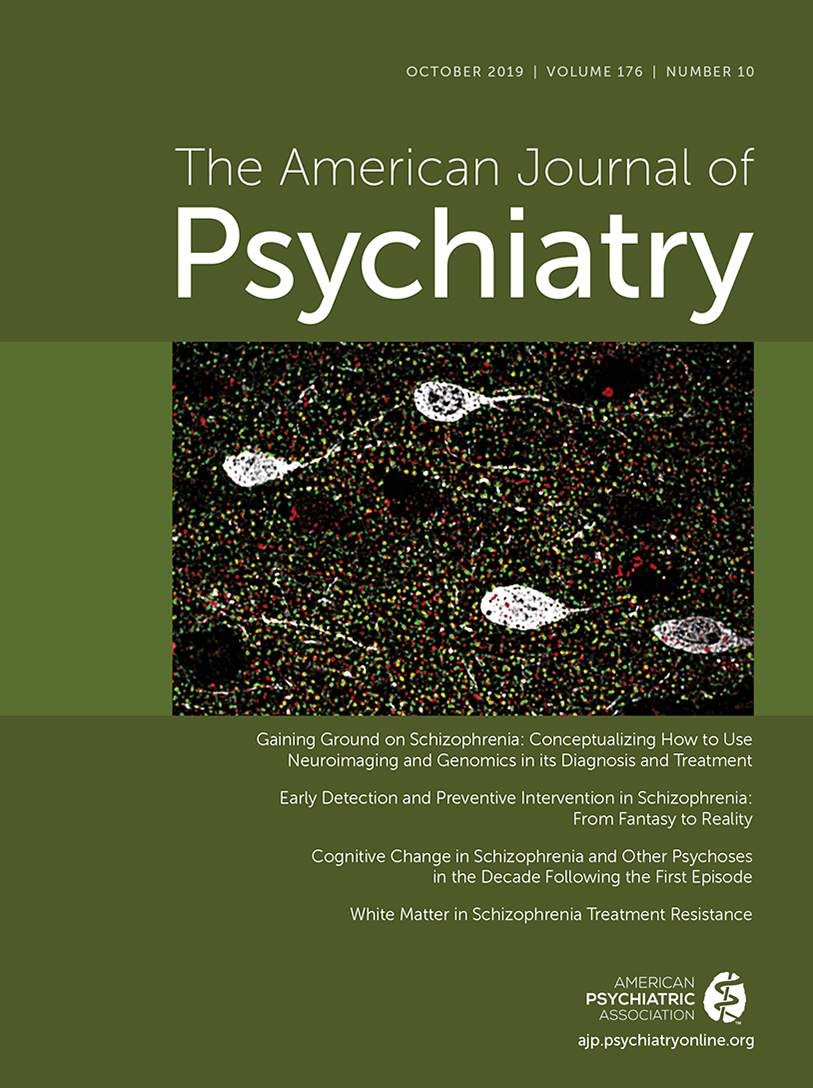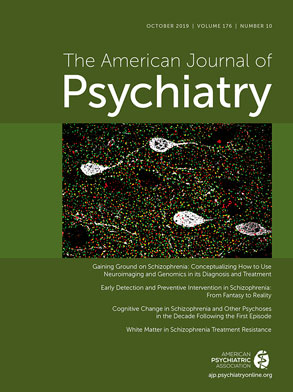Over the past few years, strong evidence has accumulated that risk for schizophrenia is influenced by a very large number of common genetic variants that individually increase risk only to a very small extent. The risk conveyed by these variants seems to act in a cumulative manner, and integrating the risk across all variants in so-called polygenic risk scores (PRSs) has been shown to explain over 18% of variance in case-control status (
1). These PRSs are defined by genetic association results from large-scale genome-wide association studies (GWASs), and for schizophrenia, the latest published results include data from over 40,000 cases and up to 100,000 control subjects (
1,
2). Such PRSs could be promising biomarkers to guide clinicians in diagnosis, treatment choice, and prediction of disease course. Such risk scores may also be used to identify individuals at high risk for schizophrenia before disease onset for targeted preventions and early intervention. In fact, the use of PRSs as predictors in clinical care has already been proposed for common medical disorders, including cardiovascular disease, diabetes, and cancers (
3,
4).
In order to move PRSs to clinical use, including in psychiatry, a number of steps need to be taken. Given that the PRS for schizophrenia currently explains the highest proportion of phenotypic variance (
1), as compared with PRSs for other psychiatric disorders, it appears to be a good test case for psychiatry. An important question to address is whether a PRS for schizophrenia developed from samples ascertained mainly in academic research settings would actually perform in real-world clinical settings. This is investigated in the article by Zheutlin et al. (
5) in this issue of the
Journal.
Zheutlin et al. report that a PRS for schizophrenia was able to detect risk for diagnosis of schizophrenia and psychosis in electronic health record data from four different health care system–based biobanks. This provides first evidence that in fact PRS for schizophrenia could be applied in real-world health care settings. In these samples, the odds ratio for being diagnosed with schizophrenia between individuals in the top 10% of polygenic risk compared with all others were up to 2.3 and up to 4.6 between the top 10% and the bottom 10% of polygenic risk. While these odds ratios were lower than those reported for schizophrenia case-control samples gathered in research settings (
1), they are comparable to odds ratios observed for medical disorders (
4), indicating that genetic prediction strategies developed in these medical disciplines will likely also apply to psychiatry. While these associations were highly statistically significant and a proof of concept that research-setting-derived PRSs could serve to detect risk in a health care-based setting, the effects of the PRSs were not large enough to allow high-accuracy discrimination of cases and controls.
This study is an important first step toward understanding the usefulness of schizophrenia PRS in clinical settings. It also highlights the many open questions that still need to be addressed, ranging from methodological development to improved risk scores to more clearly defining the populations they can be applied to.
First, PRSs developed in one ancestral group will not directly extend to other ancestral groups, and so far, the vast majority of GWASs have been conducted in populations of European ancestry. Recently, a GWAS for schizophrenia in East Asian populations showed that the genetic basis and biology of schizophrenia are broadly shared with individuals from European ancestry (
6). However, PRS for schizophrenia calculated on the basis of GWAS results in one population were significantly less predictive in the other population. Thus, expanding GWASs to other populations is a great need (
7) and a necessity before they can be truly relevant in a global clinical setting.
Another factor to consider when evaluating their clinical usefulness is that, as with shared genetic heritability among psychiatric but also neurological and medical disorders (
8), PRSs, including the one for schizophrenia, are pleiotropic, that is, they are associated not only with schizophrenia and psychotic disorders but also with other psychiatric and medical disorders. This was also found to be the case in the Zheutlin et al. study, where the schizophrenia PRS was shown additionally to be associated with risk for posttraumatic stress disorder, bipolar disorder, and other psychiatric disorders, with confidence intervals of odds ratios mostly overlapping with those of odds ratios for schizophrenia and psychosis. The schizophrenia PRS was also associated with some medical conditions in these samples, albeit with lower odds ratios. Such pleiotropy in prediction raises issues for clinical implementation. How, for example, should risk for rarer versus more common disorders be weighed in guiding clinical decisions and interventions?
It also needs to be evaluated whether PRSs developed in one clinical context can predict diagnoses in another—for example, whether PRSs developed from samples of adult patients can predict the same diagnosis in younger individuals (
9); the same question arises for sex-specific PRSs. In medical disorders, some studies have taken the approach of integrating PRSs into multimodal prediction models (
3) with added value of the inclusion of PRSs. A PRS for coronary artery disease, for example, has been shown to increase the accuracy of established clinical predictors, such as the Framingham Risk Score (
10). Another question that remains to be resolved is what kind of GWASs will be able to generate the most clinically useful PRSs. Will GWASs from large case-control samples be able to add to patient stratification and inform diagnosis and treatment? Will it be necessary to evaluate PRSs for different disorders for the same patient in order to obtain clinically relevant insight? Or will we need to generate PRSs from intermediate phenotypes, be it behavioral or biological—for example, neuroimaging measures—to maximize clinical usefulness? For predicting risk for cardiovascular disease, for example, PRSs from GWASs for lipid levels are evaluated (
11). With ever-expanding samples, diverse phenotyping, and the cost of GWASs dropping consistently, these questions may be addressed in the near future.
Finally, we need to better understand which PRSs will be most useful for clinical use. Will they allow us to disentangle clinically relevant subtypes of patients even if they are derived from large, highly heterogeneous samples? Will they be able to inform on disease course or allow us to optimize treatment selection? For medical disorders, it has been proposed that PRSs may be most useful for prevention (
3). In children with a family history of type 1 diabetes, for example, a PRS for this disorder was able to predict progression to diabetes before any metabolic abnormalities were present (
12). Such an application may be relevant for adolescents at high risk for schizophrenia and inform targeted prevention and interventions studies. Studies such as the one by Zheutlin et al. are important steps on the road to evaluation of the potential of PRSs in clinical use in psychiatry.

